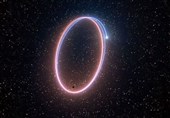Scientists Recreate Giant Collision between Two Black Holes
TEHRAN (Tasnim) – Gravitational-wave astronomers have for the first time detected a collision between two black holes of substantially different masses — opening up a new vista on astrophysics and on the physics of gravity.
A colossal collision of two black holes 2.4 billion light years away was detected by astronomers last year, but fresh developments show that the reverberations – both figurative and literal – have been felt ever since.
The galactic smash was not between two equally sized black holes, as initially thought, but was instead the violent coming together of one black hole weighing in at 29.7 solar masses and another weighing just 8.4 solar masses – a bit of a mismatch, by anyone's calculations.
A new video below shows the discrepancy in weight class between these two gravitational giants.
 As it turns out, despite the enormous combined masses involved, the collision marked the lowest-mass black hole collision humanity has ever detected – but even so, it affords the Earthbound scientific community vast troves of data to pore over for years to come.
As it turns out, despite the enormous combined masses involved, the collision marked the lowest-mass black hole collision humanity has ever detected – but even so, it affords the Earthbound scientific community vast troves of data to pore over for years to come.
“This observation lets us test our predictions for gravitational wave signals in a new way, and is another piece in the puzzle of understanding how binary black holes form,” said astronomer Christopher Berry of Northwestern University.
Among the bizarre and haunting noises produced by the collision were two distinct frequencies that were, rather amazingly, an interval of five notes apart – or, in music parlance, a perfect fifth (think the first two notes of 'Twinkle Twinkle').
The team were able to use these frequencies generated by the collision to once again test Einstein's theory of general relativity, while also determining that the larger of the two black holes was indeed spinning – something hitherto achieved only twice before.






